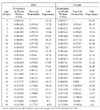Hi all,
I was wondering if you could please help with understanding the example, I understand how to calculate the expected payout and from this the present value of payout, but I don't understand what Y is, what the emboldened formula means and where the value 1.959793 comes from. To summarise, I'm not understanding how to calculate breakeven annual premium in the last emboldened line. I've attached the mortality table for reference.
EXAMPLE: Breakeven Premium Payments
The relevant interest rate for insurance contracts is 3% per annum (semiannual compounding applies), and all premiums are paid annually at the beginning of the year. A $500,000 term insurance contract is being proposed for a 60-year-old male in average health. Assuming that payouts occur halfway throughout the year, calculate the insurance company’s breakeven premium for a one-year term and a two-year term.
Answer:
One-year term:
The expected payout for a one-year term is 0.011197 × $500,000 = $5,598.50. Assuming the payout occurs in six months, the breakeven premium is: $5,598.50 / 1.015 = $5,515.76.
Two-year term:
The expected payout for a two-year term is the sum of the expected payouts in both the first year and the second year. The probability of death in the second year is (1 − 0.011197) × 0.012009 = 0.011874, so the expected payout in the second year is 0.011874 × $500,000 = $5,937.27. If the payout occurs in 18 months, then the present value is $5,937.27 / (1.015)^3 = $5,677.91. The total present value of the payouts is then $5,515.76 + $5,677.91 = $11,193.67.
The first premium payment occurs immediately (i.e., beginning of the first year) so it is certain to be received. However, the probability of the second premium payment being made at the beginning of the second year is the probability of not dying in the first year, which is 1 − 0.011197 = 0.988803. The present value of the premium payments (using Y as the breakeven premium) = Y + (0.988803Y / 1.015^2) = 1.959793Y.
Computing the breakeven annual premium equates the present value of the payouts and the premium payments as follows: 11,193.67 = 1.959793Y. Solving for Y, the breakeven annual premium is $5,711.66.
I was wondering if you could please help with understanding the example, I understand how to calculate the expected payout and from this the present value of payout, but I don't understand what Y is, what the emboldened formula means and where the value 1.959793 comes from. To summarise, I'm not understanding how to calculate breakeven annual premium in the last emboldened line. I've attached the mortality table for reference.
EXAMPLE: Breakeven Premium Payments
The relevant interest rate for insurance contracts is 3% per annum (semiannual compounding applies), and all premiums are paid annually at the beginning of the year. A $500,000 term insurance contract is being proposed for a 60-year-old male in average health. Assuming that payouts occur halfway throughout the year, calculate the insurance company’s breakeven premium for a one-year term and a two-year term.
Answer:
One-year term:
The expected payout for a one-year term is 0.011197 × $500,000 = $5,598.50. Assuming the payout occurs in six months, the breakeven premium is: $5,598.50 / 1.015 = $5,515.76.
Two-year term:
The expected payout for a two-year term is the sum of the expected payouts in both the first year and the second year. The probability of death in the second year is (1 − 0.011197) × 0.012009 = 0.011874, so the expected payout in the second year is 0.011874 × $500,000 = $5,937.27. If the payout occurs in 18 months, then the present value is $5,937.27 / (1.015)^3 = $5,677.91. The total present value of the payouts is then $5,515.76 + $5,677.91 = $11,193.67.
The first premium payment occurs immediately (i.e., beginning of the first year) so it is certain to be received. However, the probability of the second premium payment being made at the beginning of the second year is the probability of not dying in the first year, which is 1 − 0.011197 = 0.988803. The present value of the premium payments (using Y as the breakeven premium) = Y + (0.988803Y / 1.015^2) = 1.959793Y.
Computing the breakeven annual premium equates the present value of the payouts and the premium payments as follows: 11,193.67 = 1.959793Y. Solving for Y, the breakeven annual premium is $5,711.66.

